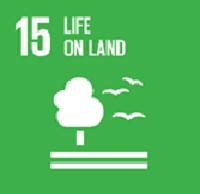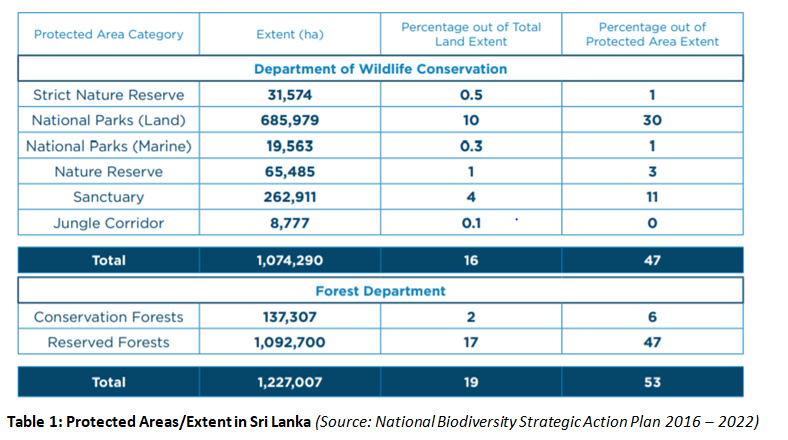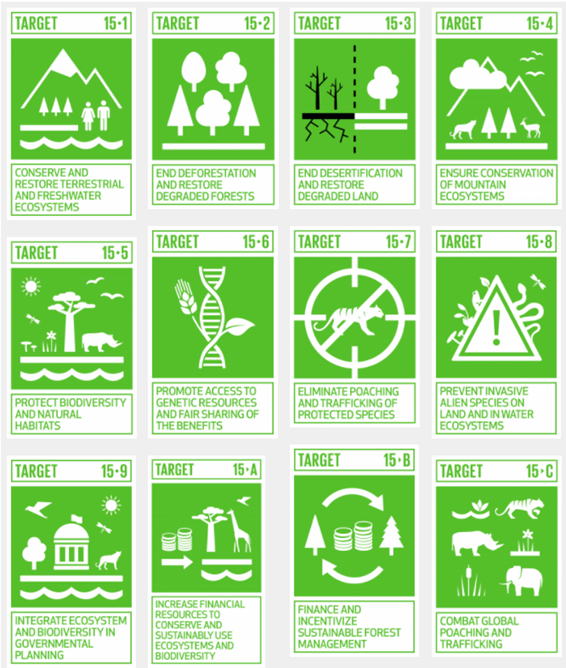Sustainable Development Goal (SDG 15): ‘Life on land’ - Engineers are key stakeholders in the sustainable use of ecosystems and preserving biodiversity
By Eng. (Dr.) Saja A. A. Majeed
 Land is a fundamental resource for dignified human living, primarily for safer dwelling in this era. It is required for developing a number of socio-economic sectors too, such as agriculture, forestry, irrigation, plantation, and industries, apart from the need for other large-scale physical infrastructures such as highways and powerplants. As we are aware, Environmental Impact Assessment (EIA) is one of the key assessments carried out in any of the feasibility studies for development projects. Engineers responsible for designing infrastructure development projects are one of the key stakeholders in the land use planning, which also make them as key decision makers in the sustainable use of land while protecting the ecosystems and biodiversity.
Land is a fundamental resource for dignified human living, primarily for safer dwelling in this era. It is required for developing a number of socio-economic sectors too, such as agriculture, forestry, irrigation, plantation, and industries, apart from the need for other large-scale physical infrastructures such as highways and powerplants. As we are aware, Environmental Impact Assessment (EIA) is one of the key assessments carried out in any of the feasibility studies for development projects. Engineers responsible for designing infrastructure development projects are one of the key stakeholders in the land use planning, which also make them as key decision makers in the sustainable use of land while protecting the ecosystems and biodiversity.
Every SDG needs engineers. How can engineers contribute to attain Sustainable Development Goal (SDG) 15 – ‘Life on land’, which is to protect, restore and promote sustainable use of terrestrial ecosystems, sustainably manage forests, combat desertification, and halt and reverse land degradation and halt biodiversity loss. The SDG 15 deals with three main aspects: managing forests, preserving biodiversity, and combating desertification. The Clause 3 of the code of ethics for professional engineers by the Institution of Engineers Sri Lanka (IESL) clearly articulates that “Engineers shall be committed to the need for sustainable management of the planet's resources and seek to minimize adverse environmental impacts of their engineering works or applications of technology so as to protect both present and future generations”. This code is a good example for the utmost important given in the engineering profession for three key aspects of SDG15 mentioned above.
Sri Lanka is one of the 35 biodiversity hotspots in the world. Around 35% (2.3 million ha) of the total land extent is under protected areas, which includes 16% of nature reserves/parks/sanctuary and 19% forests (Table 1). However, the rate for deforestation has increased over the past decades with the population growth (UN-REDD 2014). The per capita availability of land resources has decreased by six times from 1.8 ha in 1900 to 0.3 ha in 2010. The land scarcity has caused many social problems such as lack of land for proper garbage disposal particularly in the urban areas and further expansion of industries. Land use for expanding tourism development projects without harming the environment is another challenge for Sri Lanka that needs to be addressed through innovative approaches.
A long-lasting problem that is particularly of importance in the SDG15 goal to Sri Lanka is the Human-Elephant Conflict (HEC). In Asia, India also has the largest number of elephants in a single country, followed by Sri Lanka. However, in Sri Lanka, over 70% of the elephant movements lie outside of protected areas (PA), which creates more spaces for human–elephant interaction and hostility (Kopke 2021). It should be appreciated that the professional organisation such as the IESL has taken initial steps to create a forum for engineers to find innovative solutions to the HEC to prevent it becoming an emerging adversity in the country, which has been already suffering with many hundreds of human losses annually due to climate induced disasters and tragic traffic accidents.
 Source: Eng. Ranjith Sepala Chairman SLSEA
Source: Eng. Ranjith Sepala Chairman SLSEA
Global key figures related to ‘Life on land’ (SDG15)
Some of the relevant global key figures related to ‘Life on land’ provided in the United Nation statistics include (https://sdgs.un.org/goals/goal15):
- The proportion of forest area fell from 31.9 per cent of total land area (2000) to 31.2 per cent (2020), representing a net loss of almost 100 million hectares of the world’s forests.
- In 2020, 43% of each terrestrial key biodiversity area, 42% of each freshwater key biodiversity area, and 41% of each mountain key biodiversity area were within protected areas [an increase of 13% to 14% points since 2000].
- Green coverage (forests, grasslands, croplands and wetlands) of the world’s mountains is around 73% [2000 and 2018]
- Green coverage (forests, grasslands, croplands and wetlands) of the world’s mountains is around 73% [2000 and 2018]
- The Red List Index, which ranges 0-1 [0 means the extinction of all species and 1 means no risk of extinction] decreased from 0.81 [1993] to 0.73[2021].
SDG 15 (Life on land) targets
SDG 15 sets out nine key targets and three additional targets (15.a, 15.b, and 15.c) for resource mobilisation and policy to be achieved by 2030. The 12 key targets are:
15.1. By 2020, ensure the conservation, restoration and sustainable use of terrestrial and inland freshwater ecosystems and their services, in particular forests, wetlands, mountains and drylands, in line with obligations under international agreements
15.2. By 2020, promote the implementation of sustainable management of all types of forests, halt deforestation, restore degraded forests and substantially increase afforestation and reforestation globally
 Detail indicator descriptions are available at https://unstats.un.org/sdgs
Detail indicator descriptions are available at https://unstats.un.org/sdgs
15.3. By 2030, combat desertification, restore degraded land and soil, including land affected by desertification, drought and floods, and strive to achieve a land degradation-neutral world
15.4. By 2030, ensure the conservation of mountain ecosystems, including their biodiversity, in order to enhance their capacity to provide benefits that are essential for sustainable development
15.5. Take urgent and significant action to reduce the degradation of natural habitats, halt the loss of biodiversity and, by 2020, protect and prevent the extinction of threatened species
15.6. Promote fair and equitable sharing of the benefits arising from the utilization of genetic resources and promote appropriate access to such resources, as internationally agreed
15.7. Take urgent action to end poaching and trafficking of protected species of flora and fauna and address both demand and supply of illegal wildlife products
15.8. By 2020, introduce measures to prevent the introduction and significantly reduce the impact of invasive alien species on land and water ecosystems and control or eradicate the priority species
15.8. By 2020, introduce measures to prevent the introduction and significantly reduce the impact of invasive alien species on land and water ecosystems and control or eradicate the priority species
15.a. Mobilize and significantly increase financial resources from all sources to conserve and sustainably use biodiversity and ecosystems
15.b. Mobilize significant resources from all sources and at all levels to finance sustainable forest management and provide adequate incentives to developing countries to advance such management, including for conservation and reforestation
15.c. Enhance global support for efforts to combat poaching and trafficking of protected species, including by increasing the capacity of local communities to pursue sustainable livelihood opportunities
SDG 15 (Life on land) target indicators (examples)
The achievement of ‘Life on land’ goal is measured by set of key indicators. Some of them include:
- Forest area as a proportion of total land area
- Proportion of important sites for terrestrial and freshwater biodiversity that are covered by protected areas, by ecosystem type
- Progress towards sustainable forest management
- Proportion of land that is degraded over total land area
- Coverage by protected areas of important sites for mountain biodiversity and Mountain Green Cover Index
- Red link index and proportion of traded wildlife that was poached or illicitly trafficked
Current status of SDG 15 progression in Sri Lanka
The current status of achieving SDG 15 in Sri Lanka was reported in the recent review by the Government of Sri Lanka (SLVNR 2018). Some of the key contributions include:
- Forests in the south-western quarter have the highest biological diversity, which includes 49,098 ha of World Heritage Reserves and 41,823 ha of Biosphere Reserves
- 44% of flowering plants, freshwater fish (50%), amphibians (65%), reptiles (50%), resident birds (27%) and mammals (55%) were listed as threatened species in the national Red List
- The growth of the export plantation in the wet zone, the commercial timber extraction, colonization schemes and irrigation development in the dry zone and agricultural expansions have led to the decrease in forest cover over the past decades
- Sri Lanka is a signatory to international Convention on Biological Diversity (CBD) and International Plant Protection Convention (IPPC), and it has local policies and laws on the management of forest and wildlife resources [For example, Forest Ordinance, National Forest Policy, Fauna and Flora Protection Ordinance, the Man and Biosphere (MAB), Programme, the National Heritage Wilderness Areas Act, and the National Policy for Wildlife Conservation]
- 212 human lives and 4,070 incidents of property damages while resulting in 715 elephant deaths during 2014-2016 [On average, 225 elephants and 70 people die annually]
Role of engineering to advance SDG 15 - ‘Life on land’
Some selected examples from world reputed engineering organizations are briefly highlighted below:
- The use of sensor and drone technologies to map the endangered species population, participatory geographic information systems, remote sensing, satellite based geo-location and 3D-modelling in the agriculture sector for mapping and analysing the forest cover and natural resources, are some other example how engineering and technology, particularly geo-engineering innovations can help to contribute to the targets of SDG15 (UNESCO 2021).
- Sustainable engineering is key concept that promotes the designing or operating systems such that they use energy and resources sustainably, in other words, at a rate that does not compromise the natural environment, or the ability of future generations to meet their own needs. For example, a construction may destroy or disturb natural vegetation and wildlife, cause high soil erosion, create a large amount of construction waste, and have a negative aesthetic impact. The alternative approach was to convert these problematic trade-offs into benefits. That require some additional investment and a wider range of collaboration among civil engineers, ecologists, and landscape architects. The result was creation of a permanent, landscaped, ecologically compatible relief channel, with amenities and environmental features of a natural river, which eventually became an asset to the community and increased the quality of life (Pennstate University and SERINA 2019).
- If engineers want to be actors in regenerative development, they must look beyond the boundaries of their profession, looking for wholistic approaches than the reductionist approaches. The system interactions and dynamics are mostly not taken in to consideration in decision making through very specialised unique disciplinary approaches. The values, ethics and transparency into all economic, political and societal actions are vital to deal with the complex challenges such as bio diversity loss and climate change (RAE 2016, George 2019).
Next SDG: SDG 16 – Peace, Justice and Strong Institutions
In the next issue of digital SLEN, we will continue with the snapshot of SDG 16: “Peace, Justice and Strong Institutions ‘’. All SDGs are well connected, and thus require a holistic view to address real development challenges. Until then, let us reflect on SDG 15: ‘Life on land’ and its central role in the Engineering sector and profession. Your comments on how we as engineers can contribute to achieve SDGs can be posted in the IESL Facebook page https://www.facebook.com/IESLSriLanka/.
References
- https://unstats.un.org/sdgs/indicators/Global%20Indicator%20Framework%20after%202019%20refinement_Eng.pdf
- https://country-profiles.unstatshub.org/lka#goal-13
- Sri Lanka Voluntary National Review (SLVNR) on the Status of Implementing Sustainable Development Goals, 2018. Ministry of Sustainable Development, Wildlife and Regional Development, Published by the Ministry of Sustainable Development, Wildlife and Regional Development in June, 2018.
- https://www.raeng.org.uk/publications/other/engineering-a-better-world-brochure
- UNESCO (2021) United Nations Educational, Scientific and Cultural Organization, Engineering for Sustainable Development - Delivering on the Sustainable Development Goals, March 2021, https://unesdoc.unesco.org/ark:/48223/pf0000375644/PDF/375644eng.pdf.multi
- https://dashboards.sdgindex.org/static/countries/profiles/Sri%20Lanka.pdf
- https://wec2019.org.au/2019/09/05/every-sustainable-development-goals-needs-engineers/
- UN-REDD Programme (2014), Drivers of Deforestation and Forest Degradation in Sri Lanka: Assessment of Key Policies and Measures.
- Köpke, S., Withanachchi, S. S., Pathiranage, R., Withanachchi, C. R., Udayakanthi, T. G. D., Nissanka, N. M. T. S., ... & Thiel, A. (2021). Human—Elephant Conflict in Sri Lanka: A Critical Review of Causal Explanations. Sustainability, 13(15), 8625.
- https://www.e-education.psu.edu/eme807/node/3
- Sustainability Education and Research IN Action [SERINA] is a global engineering education initiative of the International Association for Continuing Engineering Education (IACEE), http://serina.iacee.org/
- George Profitiliotis, SDG 15 Life on Land, 2019. https://www.unoosa.org/documents/pdf/SpaceforYouth/SDG15_George_Profitiliotis.pdf
 Eng. Saja A.A. Majeed
Eng. Saja A.A. Majeed
BscEng, MScEng, PhD
Lecturer
Faculty of Engineering
South Eastern University of Sri Lanka




